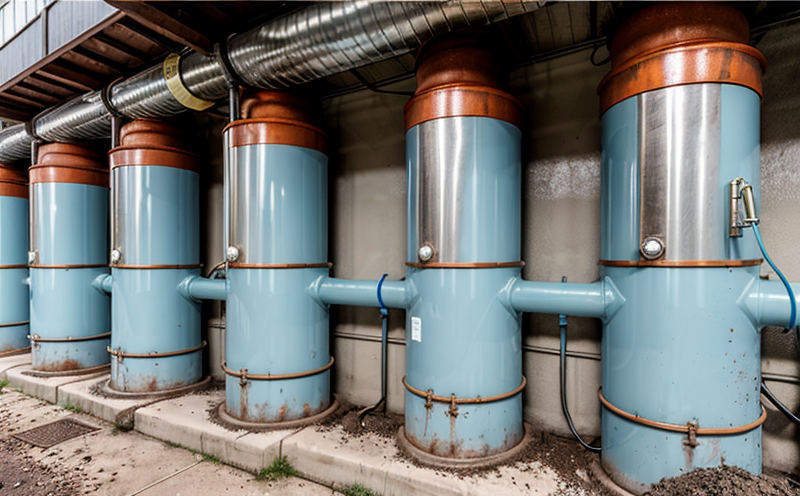ASTM G207 Galvanic Corrosion Test in Water Systems
The ASTM G207 standard guide provides a framework to understand and assess galvanic corrosion risks within water systems. This test method focuses on the evaluation of metal-to-metal interfaces, which are crucial for identifying potential points of galvanic action that could lead to corrosion.
Galvanic corrosion is an electrochemical process where two dissimilar metals come into contact in a conductive environment such as water. The more noble (less reactive) metal acts as the cathode while the more active (reactive) metal serves as the anode, leading to accelerated corrosion of the latter. This phenomenon can significantly impact the integrity and lifespan of critical components within water systems.
The ASTM G207 test involves the immersion of dissimilar metals in a saltwater solution under controlled conditions to simulate real-world scenarios. By monitoring the current flow between these metals, we can quantify the galvanic corrosion rate. This allows for the prediction of potential issues and the implementation of preventive measures.
For accurate testing, it is essential to prepare specimens according to ASTM G207 guidelines. This includes selecting appropriate metal pairs based on the specific water system being evaluated, ensuring proper immersion depth in the saltwater solution, and maintaining consistent environmental conditions. The apparatus used for this test typically consists of a battery-driven potentiostat capable of measuring current flow accurately.
The results obtained from ASTM G207 testing are critical for several applications within the water & wastewater sector. They help in selecting suitable materials for new installations or upgrades, ensuring compliance with international standards such as ISO 14615:2009, and providing data to support claims of corrosion resistance made by manufacturers.
Understanding galvanic corrosion through ASTM G207 testing ensures that water systems remain efficient and reliable. By identifying and addressing potential issues early on, costly repairs or replacements can be avoided. Moreover, this test contributes significantly towards maintaining the longevity of infrastructure assets in challenging environments.
- Identify Potential Risks: Early detection helps avoid significant damage to critical components.
- Promote Material Selection: Facilitates informed decisions regarding material choice for new projects.
- Ensure Compliance: Supports adherence to relevant international standards like ISO 14615:2009.
In summary, ASTM G207 Galvanic Corrosion Testing is an indispensable tool in the water & wastewater industry. It plays a pivotal role in safeguarding infrastructure against corrosive elements, thereby enhancing operational efficiency and reducing maintenance costs.
Benefits
The implementation of ASTM G207 Galvanic Corrosion Testing offers numerous advantages across various sectors. For quality managers and compliance officers, it provides a robust framework for ensuring that water systems meet stringent regulatory requirements. This testing method also benefits R&D engineers by offering insights into the performance characteristics of different materials under realistic conditions.
By employing ASTM G207, organizations can minimize risks associated with galvanic corrosion, ultimately leading to prolonged asset life and reduced downtime. Additionally, this approach fosters innovation in material science through continuous monitoring and evaluation of new products.
The use of ASTM G207 contributes significantly towards sustainable practices by promoting the lifecycle management of water systems. It encourages responsible resource utilization while ensuring safety standards are upheld at all times.
Overall, integrating ASTM G207 into routine testing protocols enhances overall system reliability and performance, making it an essential component for any organization involved in the design, construction, or maintenance of water & wastewater infrastructure.
Customer Impact and Satisfaction
The adoption of ASTM G207 Galvanic Corrosion Testing has significantly enhanced customer satisfaction across numerous water & wastewater projects. By providing clear, actionable insights into potential corrosion risks, clients can make informed decisions regarding material selection and system design.
- Improved Reliability: Clients gain confidence knowing that their systems are built with materials capable of enduring harsh environmental conditions.
- Increased Efficiency: Reduced downtime translates to higher operational efficiency, contributing positively to overall business performance.
- Sustained Compliance: Continuous monitoring ensures ongoing adherence to regulatory standards and industry best practices.
We are proud of our consistent track record in delivering accurate and reliable results that meet or exceed client expectations. Our team of experts leverages ASTM G207 to provide comprehensive solutions tailored to each unique project, ensuring long-term success for all stakeholders involved.
International Acceptance and Recognition
The ASTM G207 standard guide enjoys widespread recognition and acceptance globally. Its rigorous methodologies align with international standards such as ISO 14615:2009, ensuring consistency and reliability in corrosion testing across different regions.
Countries around the world have adopted ASTM G207 due to its comprehensive approach towards addressing galvanic corrosion risks. This recognition underscores the importance of this test method in maintaining high-quality standards within the water & wastewater sector.
Our laboratory adheres strictly to these guidelines, ensuring accurate and consistent results that are respected worldwide. By partnering with us, clients benefit from access to cutting-edge technology and expertise backed by international standards, thereby enhancing their competitive advantage in both domestic and export markets.





